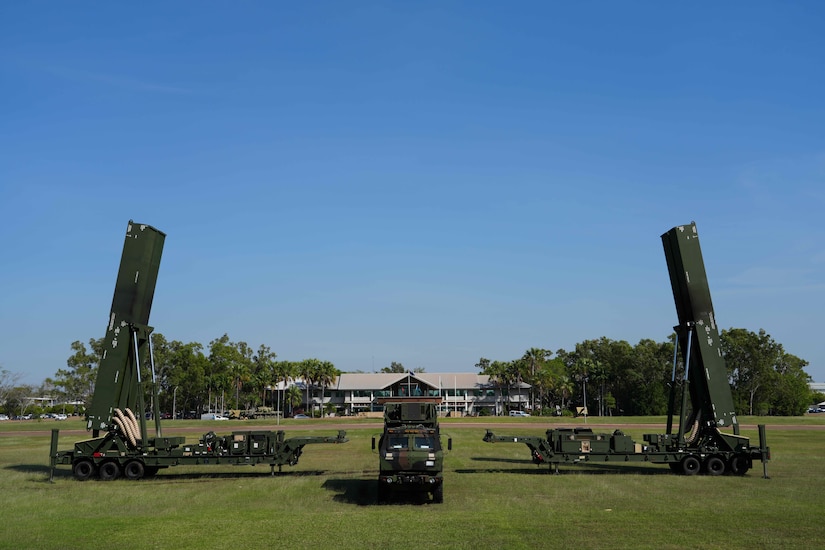The United States deployed its ‘Dark Eagle’ Long-Range Hypersonic Weapon (LRHW) during the Talisman Sabre military drills in Australia. This marks the first-ever overseas deployment of this sophisticated system and represents a major milestone for the Pentagon.
The US Army deployed the Dark Eagle hypersonic missile system to Australia’s Northern Territory on August 2, as part of the Talisman Sabre 2025 multi-national military exercise. Described as a historic milestone by the US Indo-Pacific Command, this deployment was managed by the 3rd Multi-Domain Task Force (3MDTF), based in Hawaii.
“The deployment of the LRHW system to Australia marks a significant achievement for U.S. Indo-Pacific Command, as it validates the Army’s ability to deploy, position, and exercise command and control (C2) of the system in a forward environment,” said Adm. Samuel J. Paparo, Commander of U.S. Indo-Pacific Command. “The exercise demonstrates the Combatant Command’s capacity to project power and support the defense of Australia, a key ally in the region.”
With this test, the Dark Eagle has become the latest entrant into a list of firsts that happened during the multinational exercise.
Talisman Sabre 2025 witnessed the first live firing of the Australian M142 High Mobility Artillery Rocket System (HIMARS), including the use of the Precision Strike Missile, and the first live firing with the US Typhon Mid Range Capability (MRC), as reported by the EurAsian Times.
Col. Wade Germann, the commander of the multidomain task force, said that Dark Eagle’s debut Down Under (a reference to Australia) shows the Army’s ability to rapidly deploy and operate advanced capabilities. According to images released on August 2, the deployment began as early as July 9 and involved at least two missile launchers at an undisclosed location in the Northern Territory.
This deployment is significant as the United States continues to trail behind its adversaries in the hypersonic weapons race. In general, hypersonic missiles travel at five times the speed of sound (Mach 5) and follow an unpredictable trajectory, which makes them much harder to intercept by usual air defense systems.
The primary US adversary in the world, China, has arguably emerged as the world leader in hypersonic capabilities. At least two additional hypersonic weapons emerged in the last year—the DF-27 and an air-launched variant of the YJ-21, respectively.
Meanwhile, Russia has already used two of its hypersonic weapons—the Kinzhal and Zircon—in combat against the Ukrainian forces. Incidentally, even countries that are considered rogue, like Iran and North Korea, are alleged to have operational hypersonic weapons.
The Dark Eagle will be crucial in a potential conflict with China, which is technically never off the table. China has been pursuing an area-denial, anti-access policy with missiles aimed at ships and airplanes in the South China Sea and close to Taiwan.
The Dark Eagle hypersonic weapons will provide the US Army with a strategic, long-range strike capability to counter the Chinese anti-access/area denial (A2/AD) systems, suppress enemy air defenses, and engage time-sensitive targets.
The deployment underscored the system’s role in Indo-Pacific deterrence, particularly against potential threats from China.

Moreover, the Dark Eagle’s deployment in Australia is noteworthy as the US is planning to deploy hypersonic weapons in the country, which is strategically located in the Pacific and expected to be a party in a potential US-China conflict.
While the Australian leadership has not explicitly stated that it would aid the United States against China, the military ties between the two allies are robust. This essentially means that Canberra’s participation in such a conflict cannot be ruled out.
The US military publication Star and Stripes was reportedly informed by Lt. Gen. Joel Vowell, deputy commander of US Army Pacific, that the Army is working with Australia’s 10th Brigade in Adelaide, South Australia, to plan the deployment of hypersonic weapons. “We are looking at how we can do that together,” he said.
The 10th Brigade is a new unit headquartered in Adelaide’s Edinburgh Defence Precinct. It is expected to be armed with the National Advanced Surface-to-Air Missile System (NASAMS) and the M142 High-Mobility Artillery Rocket System (HIMARS), the designated launch platform for the long-range Precision Strike Missile.
The EurAsian Times could not confirm the plans for the deployment of Dark Eagle in Australia or the status of relevant talks. However, we do know that the South Pacific country is bolstering its long-range strike capability with the help of the US, in an attempt to deter China.
Moreover, the AUKUS Pillar II pact states that the three allies will collaborate on their “advanced capabilities,” including sharing military expertise in critical areas such as long-range hypersonic missiles, undersea robotics, quantum technology, and Artificial Intelligence (AI). Thus, Canberra might have a fair chance at fielding the Dark Eagle.
US Army’s LRHW ‘Dark Eagle’
The US Army’s Long-Range Hypersonic Weapon (LRHW), commonly referred to as Dark Eagle, is a ground-launched missile system with a reported range of 1,725 miles, or about 2,776 kilometers. The system boasts a speed of Mach 17, according to reports.
A Dark Eagle battery comprises four trailer-based launchers, each accommodating two canister missiles. These launchers are transported on M870 trailers, towed by eight-wheeled M983A4 HEMTT tractor-trailer trucks. In addition, a command vehicle with six wheels serves as the Battery Operations Center, supervising the Dark Eagle system’s operations.
One of the distinctive features of Dark Eagle’s design is its unpowered hypersonic boost-glide vehicle sitting atop a rocket booster. Before being unleashed, the rocket booster raises the conical-shaped hypersonic vehicle to the optimum height and speed. It subsequently descends over a concise, atmospheric flight path at hypersonic speeds, defined as anything surpassing Mach 5.
This land-based, truck-launched weapon is capable of firing hypersonic missiles with velocities exceeding 3,800 miles per hour. By ascending to the upper reaches of the Earth’s atmosphere and remaining just out of range of traditional air and missile defense systems, these missiles quickly fall on their targets, giving enemies little time to respond.
The Army has been collaborating closely with the US Navy to develop the LRHW, which consists of the Common Hypersonic Glide Body (C-HGB) and a 34.5-inch booster designed by the Navy. While the Army’s version is launched from mobile ground platforms, the Navy’s counterpart, known as Conventional Prompt Strike (CPS), is designed for deployment from Zumwalt ships.
The missile is designed to carry a conventional warhead and is optimized for precision strikes. It can withstand extreme heat (thousands of degrees) during hypersonic flight using advanced thermal protection systems.
The missile is designed to be road-mobile for rapid deployment and survivability against enemy targeting. It can be swiftly transported on the C-17 Globemaster III for global reach.
It can operate within the Army’s Integrated Air and Missile Defense Battle Command System (IBCS), which means that the weapon can integrate with the Army, Navy, and Air Force, as well as with allied partners for synchronized strikes across domains.
It is currently based with the 1st MDTF in Washington and the 3rd MDTF in Hawaii, with plans for potential forward-basing in the Indo-Pacific or Europe. However, the system has not achieved full operational capability (FOC) yet.
Though the platform is expected to finally bridge the hypersonic gap that exists between the US and its primary adversaries, troubles continue to persist.
For instance, the annual report published by the Office of the Director, Operational Test & Evaluation (DOT&E) in February 2025 stated that the lethal effects of the Dark Eagle are still unclear to the Pentagon.
The report stated that there is insufficient data “to evaluate the operational effectiveness, lethality, suitability, and survivability of the LRHW system.”
The US Army has conducted three end-to-end tests of the missile system, and further tests are expected to help the service plug the technical flaws. The US must fix the technical issues and field a weapon soon, especially in the face of a burgeoning threat from state and non-state adversaries.



